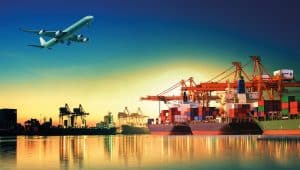Lord Waverley: The Shackles That (Still) Bind International Trade
 The ‘Problématique’
The ‘Problématique’
Notwithstanding the continued march of globalism, cross-border global trade remains plagued by multiple barriers. These impede economic development, particularly in emerging market (EM) economies, and for small and medium-sized enterprises (SMEs).
EMs account for over 85% of the global population, almost 60% of global GDP, yet only 40% of world exports. And they are an economic driving force: since the 2007 to 2009 global financial crisis they have been responsible for fully four-fifths of global growth.
Even more fundamentally, SMEs are the backbone of all economies, and the driving force of much innovation, job creation, and growth. In the OECD for example, SMEs account for more than 90% of all enterprises, between 60% and 70% of all employment, and between 30 and 70% of the total value added. Their role in exporting, however, is much smaller than that of larger enterprises. Depending on the country, SMEs contribute between 15 and 50 % of exports, whilst between 20 and 80% of SMEs are active exporters. Overall, it is estimated that SMEs contribute between 25 and 35% of world manufactured direct exports. Where information exists, it points to these exports being concentrated around relatively few larger SMEs.
Thus, collectively small and mediums-sized firms are extremely important in their home economies, but take part disproportionally little in world trade.
And this matters. If, for example, SMEs were to have the same share in international trade as larger entities, it would bring many benefits, including more efficient global supply chains, enhanced competition and technology transfer, higher productivity, wages, and employment, and reduced EM dependency on aid.
Clearly one or more factors are inhibiting, or preventing, SMEs from exporting.
Inhibiting Factors
The factors inhibiting would-be international suppliers of goods and services are many, various, and multi-level. They range from lack of information and transparency; to problems of language and culture; to differing regulations and standards; and constraints on access to finance, insurance, and ultimate payment. International tendering and contracting in particular is simply too painful and too costly to undertake.
The result is that for many, exporting is simply too difficult, with such little practical support as is available being woefully inadequate.
The Resource Constraint
Companies in emerging markets generally have fewer resources with which to promote their exports than do their counterparts in the developed world; and the help available too tends to be less resolute.
SMEs for their part tend to be particularly resource constrained, in all countries, relative to their bigger corporate cousins; and in emerging market countries many face particularly severe constraints, with little internal capacity to identify, let alone follow up, potential opportunities.
Governments can help; but what they can offer is limited. In any case, governments should attempt to do only what only they can do – which is basically to provide a supportive macro environment, including a robust, fit-for-purpose institutional framework within which the private sector can thrive. Depending on their political philosophy, some governments will accept more, and some less, social and other responsibilities than others. But whatever the help provided by government, in all countries a major part of the challenge rests with the private sector. The playing field is far from level.
A further issue is that most governmental policies are intrinsically either national or at most region-wide: comparatively few efforts are made to approach these issues at the global level. A greater understanding is emerging of how best to assist companies globally in entering new cross-border markets; and the new technologies offer considerable scope for putting them into practice.
Some Important Overarching Principles
A number of overarching principles that ought to be regarded as central to any programme aimed at increasing cross-border trade include:
- Taking both a truly top-down, global, and holistic approach.
- Ensuring clear alignment of business, national, and international objectives.
- Targeting policy especially towards SMEs and emerging markets.
- Constructing policies in consultation with key stakeholders.
- Growing an export culture and raising international ambition, including through government briefings, school education, improved teaching of modern languages, and advisory services.
- Examining the range of existing policies, and best practice from around the world.
- Setting up working groups that are government-backed.
- Regulating to facilitate, rather than to control.
- Seeking to eliminate inadvertent constraints, to put competition on an even footing internationally.
Key Areas of Focus
Some areas that are central to any programme aimed at increasing cross-border trade include:
- Language and culture. Cross-border trade is reliant on overcoming language barriers and understanding cultural differences.
- Legal and regulatory factors, including labelling, branding, patents, copyright and trademarks, rights of distributors/sales agents abroad, and compliance with local health and safety are cited by SMEs in particular as being a major obstacle to exporting. Harmonisation wherever possible is always of benefit.
- Finance and insurance. Most firms are heavily reliant on (only a few) banks. Capital constraints often lead to trade finance and insurance options being restricted. Better and more financing options are needed.
- New technology. Advances in technology continually change the game. Recently-developed software now enables lenders to interface with, and thereby monitor and analyse, key company data along supply chains, including all-important accounts-receivable information. As a result insurance companies are more willing to offer guaranteed fixed-term insurance; banks are more willing to lend to such companies, sooner, more cheaply, and in greater volume. It has also facilitated early payment to suppliers.
- Awareness. Firms need to know about the support that is available otherwise take-up remains low.
- A one-stop information hub. A true ‘one-stop shop’ that brings together all that is needed, including importantly the brining together of suppliers and buyers, in a user-friendly centralised information hub will perforce need to be at the heart of it all.
Steps are being made in the right direction. Supplyfinder is a new multi-language “industry matchmaker” platform providing organisations around the world with a comprehensive range of practical services, to help them deepen exiting markets, open up new opportunities; and to advance international trade and investment across 195 countries.
About the Author
Lord Waverley (JD) (Member, House of Lords, London) is the founder & CEO of SupplyFinder.com.
Contact: [email protected]
You may have an interest in also reading…
As Spain and Argentina Team Up, Royal Navy Sets Sail for Gibraltar
A significant chunk of the Royal Navy has set sail for the Mediterranean and the Gulf region on what is
From Davos to Digital Transformation: The Key Trends that Will Define the Global Financial Services Sector in 2024
World leaders gathered at the Davos World Economic Forum in January and told us what we already know – that
Another Inconvenient Truth: Vice Pays
The politically correct and socially sustainable is, though certainly laudable, not particularly profitable. Investors shunning sin stocks manage portfolios that



















































































